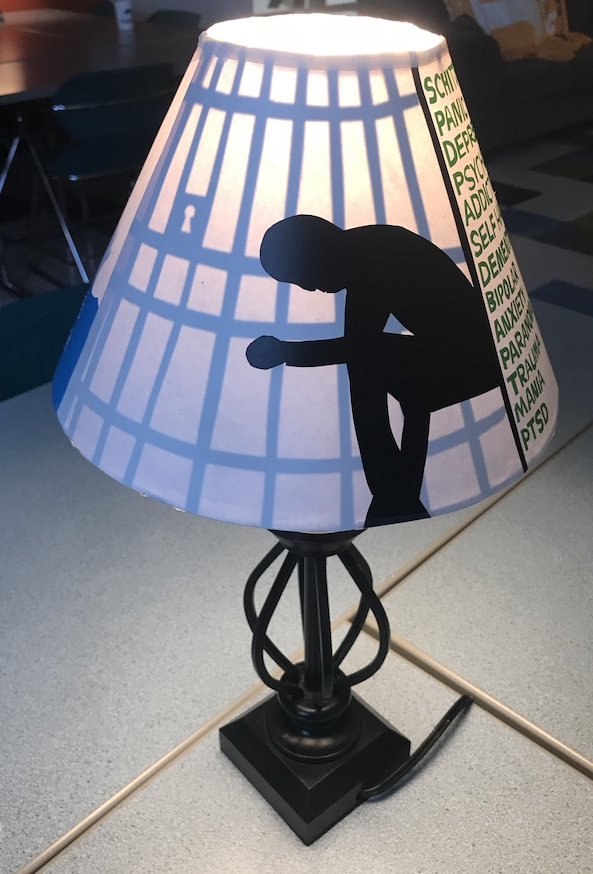
Black Panther-inspired High School lesson plan using Just Mercy by Bryan Stevenson. This lesson was revisited due to the release of the film starring Michael B. Jordan and Jamie Foxx.
These lessons are designed for 90 minute blocks – 3 week Unit.
Note:
*Option for advanced grade could include coding an Arduino so lampshade will spin. This would require more time to be added to lesson.
*Tennessee State ELA Standards addressed are located on each rubric.
Credits:
Stevenson, Bryan. Just Mercy: A Story of Justice and Redemption. Scribe, 2015.
Scheld, Melissanne. “Just Mercy by Bryan Stevenson – Teacher’s Guide.” PenguinRandomhouse.com, Sept. 2014, www.penguinrandomhouse.com/books/224792/just-mercy-by-bryan-stevenson/9780812984965/teachers-guide/.
Class set of Just Mercy by Brian Stevenson
Vinyl Cutter
Laser Cutter
Students will focus on what is wrong with the justice system based on the story, write an essay, and create a lampshade which will shine the light on issues they choose, also tying in with Black History Month.
Give students the essential question for this Unit: If given the power and resources, what would YOU do to improve/correct an area of the Justice system? In order for each student to be able to answer this question, I would have each student first “shine the light” on themselves….
Questions for students to ponder/answer:
What struggle/struggles have they endured? What is their story?
Then “shine the light” on their background
What is their culture? History? Struggles? What is a symbol of power or empowerment in their culture(s)?
And finally, “shine the light” on a national issue surrounding the justice system
What are the glaring issues of our system? Death Penalty? Mandatory Sentences? Race?
Students will “tell” their story using a lampshade – divide into 3 parts and design their shade with the answers of the 3 parts mentioned above…they can use symbols, words, images, etc.
Students will use the laser cutter and cut their shade – putting it on a lamp will let their story “shine”…
For a grade of Advanced, students will program an Arduino to make the shade spin – telling their story.
Each class will have time for discussion regarding the novel, brainstorming and planning of Lampshade, and time to work on Essay.
CLASS ONE: Introduce the novel Just Mercy by Bryan Stevenson. Give background on the author. Have students research incarceration rates in the US – give them cities to research and also their own city to compare/contrast. Discuss and assign Ch. 1-3 of the novel.
CLASS TWO: Introduce Unit Project. “See me…See my culture…See the Change…” Talk about the movie Black Panther and one possible theme of the film. (Show clip from the movie if time allows) Discuss with students how they will be shining the light on themselves and an issue they want to see changed from their reading. Go over rubric for their shade and written essay explaining their project. (will attach)
Discuss Ch.1-3 – sample questions:
In your opinion, who is the most to blame for Walter’s conviction?
How is To Kill A Mockingbird relevant to Just Mercy?
Does the State you live in have Stand Your Ground laws? Do the Research. Do you support them?
Assign Ch. 4-6
CLASS THREE: Have students begin to brainstorm struggles they have endured/research their background – Students can use Ancestry.com. Have them write questions their relatives may be able to answer.
Discuss: Based on what you know at this point in the novel, are you hopeful for Walter’s release? Why or why not? Use evidence from the novel to support your opinion.
From Chapter 6, in what ways did the judicial system fail to protect Charlie?
Assign Ch. 7-10
Introduce Laser Cutter/Vinyl Cutter – Collaborate with FabLab
CLASS FOUR:
Have students begin “prototyping” their shade. What is their story? What will they project with their shade to represent their story? Needs to be three parts – 1. Their Background/2. Their Struggles/3. What issue speaks to them the most needing change? Spend the majority of the class working on the project.
Exit Ticket – Brief assessment of Ch. 7-10 for reading/comprehension. Sample questions:
– What were some of the discoveries made by Stevenson in regards to Walter’s case?
– Summarize Antonio’s crime and punishment.
– What is your impression of Mrs. Williams?
– Who is Dorothea Dix and why is she important in Ch. 10?
Assign Chapters 11-14
CLASS FIVE:
Entire class time spent in FabLab – working on lampshades – have students give each other feedback using Critical Friends format – pair students up.
Lampshades are laser cut from heavy paper using the included template/file (PDF or SVG).
Students create 2D graphics or shapes that are “printed” on a vinyl cutter. Adhere cut shapes directly on the lampshades, or position them inside the shade where they can be revealed when the light is turned on.
Remind students to be sure and review rubric for their lampshade and essay which are due next class.
CLASS SIX:
Lampshade and essay due. Sharing with peers and presenting work.
Self-assessment to be completed as an exit ticket.
Showcase final student projects.
Here are some examples of finished lampshades:


Here is a more advanced lampshade that spins:


Having trouble? Let us know by completing the form below. We'll do our best to get your issues resolved quickly.
"*" indicates required fields
Thank you for your fab contribution!